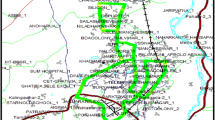Abstract
The correlated both in space and time user mobility behavior can aid significantly in the localization of a moving terminal in the network coverage area. However, there is always some uncertainty in mobile user position and a network-wide search cannot be done. Therefore, a predictive paging scheme must always be combined with a location update strategy and a compatible algorithm to conduct the search. In this paper, we introduce a new strategy that combines an optimal partitioning of the location area (LA) with a model to predict user movements, based on the additional information of the cell where the last interaction between the network and the terminal took place. We study the performance of the strategy under delay bounds and different mobility and call arrival characteristics. It is found that the new scheme further minimizes signaling costs and enhances previous sequential paging algorithms.
Similar content being viewed by others
REFERENCES
Y. Bejerano, N. Immorlica, J. Naor, and M. Smith, E. cient location area planning for personal communication systems, Proc. IEEE/ACM Mobicom '03, San Diego, CA, pp. 109–121, Sep. 2003.
S. Z. Ali, Location management in cellular mobile radio net-works, Proc. IEEE 13 th PIMRC, Lisbon, Portugal, pp. 745–749, Sep. 2002.
C. Rose and R. Yates, Minimizing the average cost of paging under delay constraints, Wireless Networks, Vol. 1, No. 2, pp. 211–219, 1995.
A. Abutaleb and V. O. K. Li, Paging strategy optimization in personal communication systems, Wireless Networks, Vol. 3, No. 3, pp. 195–204, 1997.
J. G. Markoulidakis and E. D. Sykas, Performance bounds of a multiple-step paging strategy in future universal mobile telecommunication systems, International Journal Wireless Information Networks, Vol. 2, No. 3, pp. 133–147, 1995.
B. Krishnamachari, R.-H. Gau, S. B. Wicker, Z. J. Haas, Optimal sequential paging in cellular networks, Wireless Net-works, Vol. 10, No. 2, Mar. 2004.
W. Wang, I. F. Akyildiz, and G. L. Stu ¨ber, An optimal pag-ing scheme for minimizing signaling costs under delay bounds, IEEE Comm. Letters, Vol. 5, No. 2, pp. 43–45, 2001.
S. M. Ross, Stochastic Processes, 2nd ed. John Wiley & Sons, New York, 1996.
R. M. Feldman and C. Valdez-Flores, Applied Probability and Stochastic Processes, PWS Publishing Co., Boston, 1996.
R. W. Wol., Stochastic Modeling and the Theory of Queues, Prentice-Hall, Englewood Cli. s, NJ, 1989.
Author information
Authors and Affiliations
Rights and permissions
About this article
Cite this article
Koukoutsidis, I.Z., Theologou, M.E. A Combination of Optimal Partitioning and Location Prediction to Assist Paging in Mobile Cellular Networks. International Journal of Wireless Information Networks 11, 123–129 (2004). https://doi.org/10.1007/s10776-004-7871-6
Issue Date:
DOI: https://doi.org/10.1007/s10776-004-7871-6




